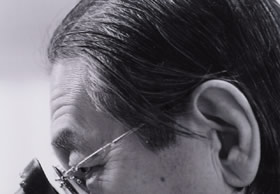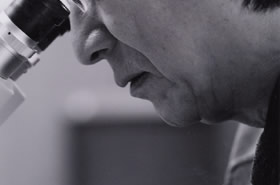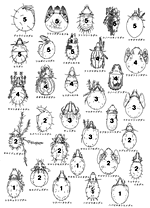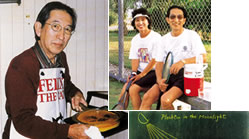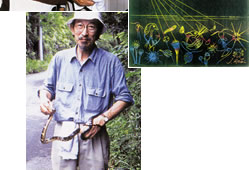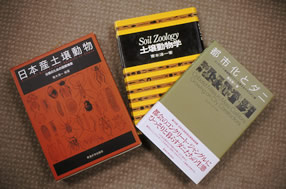 |
| Naming the earth's living creatures |
 |
 |
Human beings have a yen to name things, and living creatures are no exception. But those creatures with scientific names account no more than 1% of all creatures alive today (estimated at 100-200 million species). I am asked what is the point of classifying insects such as the oribatid mite who live under dead leaves in forests and are neither harmful nor beneficial. The point is that without a name, there will have been no record that that creature even existed. It is a matter for joy that the ibis disappeared from the wilds in Japan while everyone mourned and regretted its passing. But there are likely oribatid mites who have disappeared from the earth with no one noticing because human beings altered the environment. That is just too sad.
I have given names to 450 species of mites in 40 years. The impetus behind my work is leaving a record that mites with this type of form and this name existed on the earth. I feel as if I want to leave a record of their existence on the earth's registry of living creatures. |
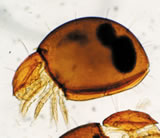 |
One of the more attractive members in the oribatid mite classification is the "himehesoire mite". On the underside of the insect is a hamburger-shaped lump of dung produced from the fallen leaves it eats. |
 |
| Coming in contact with oribatid mites |
 |
 |
I was evacuated to Nikko while in primary school. Though beset by hunger every day, I caught and sketched carrion beetles and carabids and made my own field guide for insects. My home in Tokyo was burnt out in the air raids, and after the war I lived with my grandfather in Inamuragasaki in Kamakura. My uncle was Rokuro Kano, the president of the Tokyo Medical and Dental University. He liked living creatures very much, and we used to wander in the fields together. These experiences were the reason I developed an interest in the natural sciences.
When I began research into insects at the University of Tokyo's School of Agriculture, all the talk was about killing them. There are many types of oribatid mites, and when I read a book that said there were no researchers in that field in Japan, I thought, "This is it!" A mite I collected during the summer of my third year in college was the first new species that I discovered, and it became the subject of my graduation thesis. That determined the course that I would pursue.
I received a degree from my research into the relationship between mites and the soil and vegetation, but I couldn't find a job. At a rehabilitation facility for juvenile delinquents, I supervised some young people who were organizing insect specimens on a job subcontracted from the Bishop Museum in Hawaii. After doing that for a year, frustrated, yet committed to the work, a letter came from the head of the museum's Entomology Department. He praised me for my handling of such tedious work and asked me if I wanted to come and work there. Thrilled to death, I went.
Specimens were sent to the museum from throughout the South Pacific. When I studied the mite that lived on the lichen that grows on the back of a weevil in New Guinea, I discovered a new species, a new genus, and a new family. After writing nine papers in one year, I was invited to work at the National Science Museum in Tokyo. I had finally landed a job in Japan. |
 |
Studying the oribatid
mite's Japanese environment |
 |
 |
At the museum, I looked at the oribatid mites we collected from morning until night and became engrossed in their classification. I developed a new method for collecting them. I would get low to the ground over an area 5-10 meters square and pick up different sedimented material on the forest floor. Until then, environmental scholars used a method that emphasized individual specimens, so this was an idea from a scholar interested in classification who was concerned with the species composition.
The animals that live in the forest soil are within the range of my areas of research. I wrote a paper on the conditions of their habitation, which researchers in Europe found interesting and frequently quoted. There were no textbooks in Japan on soil animals, so I wrote the 814-page Soil Zoology by myself in five years. I took all the photographs and did the plates myself.
Thanks to this book, universities contacted me and I eventually conducted research into mites at 2,900 locations throughout Japan with my assistant Hiroshi Harada of the Yokohama National University. The oribatid mite is sensitive to the degree of proximity of its environment to nature, and the composition of the species differs greatly depending on the soil. The location beneath fallen leaves is an extremely fragile one between the atmosphere and the pedosphere.
We presented an environmental diagnostic method with the ant, sow bugs, and other creatures in addition to the oribatid mite as the index animals. It has now become one of the important environmental assessment methods.
|
|
|
Gauging the abundance of nature from the composition of the oribatid mite species
I focused my attention on the species composition of the soil animals I had studied using my new method, and developed a method for environmental diagnosis by examining what type of species existed. The figure shows some of the 100 oribatid mite species used for this environmental diagnosis. The numbers on the mites are evaluation points. The types with five points are the most susceptible to environmental deterioration. |
 |
| Awareness of the species of living creatures |
 |
 |
We ask visitors to the Museum to be moved and surprised by our authentic specimens. We all want children to grab, take, or tear apart the things they find in nature. Some people are critical of insect collections, and they are upset because the insects that have been collected have died. But what's wrong with that? Using them as specimens enables people to come in contact with the depth of nature's forms.
Even with fish, different species have completely different flavors. Unfortunately, however, fish merchants today display the fish unrelated to their species. It is important to see living creatures through their species for a deep understanding of nature.
(Text: Atsushi Yamagishi) |
|
 |
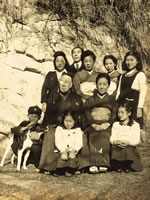 |
 At age four, in front of my grandfather's house at Inamuragasaki, Kamakura city. I am on the left. At age four, in front of my grandfather's house at Inamuragasaki, Kamakura city. I am on the left. |
 |
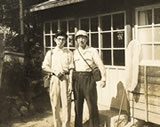 |
 At age 17, off to Nikko to collect insects with my uncle, Rokuro Kano. At age 17, off to Nikko to collect insects with my uncle, Rokuro Kano. |
 |
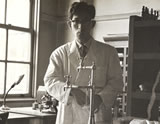 |
 At age 22, in the lab for studying harmful insects at the University of Tokyo's School of Agriculture. At age 22, in the lab for studying harmful insects at the University of Tokyo's School of Agriculture. |
 |
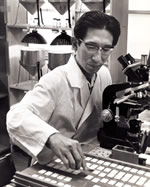 |
 At age 25, in graduate school. In the background is a Tullgren Apparatus. At age 25, in graduate school. In the background is a Tullgren Apparatus. |
 |
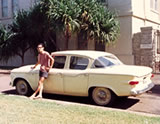 |
 In Hawaii, with a Studebaker Lark, the first car I ever bought. In Hawaii, with a Studebaker Lark, the first car I ever bought. |
 |
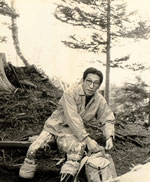 |
 Collecting soil samples while with the National Science Museum Collecting soil samples while with the National Science Museum |
 |
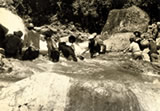 |
 On a survey of Mt. Poroshiri in Hokkaido. I crossed the muddy stream 15 times. I am fourth from the left. On a survey of Mt. Poroshiri in Hokkaido. I crossed the muddy stream 15 times. I am fourth from the left. |
 |
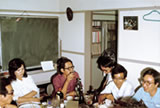 |
 At night in the lab at Yokohama National University. I am third from the left; my assistant Harada is on the far right. At night in the lab at Yokohama National University. I am third from the left; my assistant Harada is on the far right. |
 |
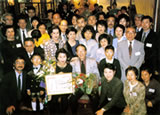 |
 During a reception when receiving a reward from the Zoological Society of Japan in 1998 During a reception when receiving a reward from the Zoological Society of Japan in 1998 |
|
